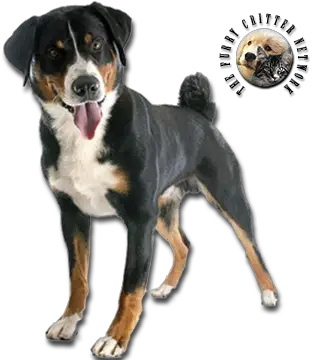Breed Standard
Head: Slightly wedge-shaped. Stop not pronounced. Rectangular nose bridge. Black or brown nose. Tight lips.
Ears: Set on high, triangular, drop, lying against the head.
Eyes: Small, almond. Dark brown to chestnut color.
Body: Robust, compact. Strong, dry neck. Broad chest is well let down. Prominent forechest. Belly slightly tucked up. Straight, solid back. Short croup.
Tail: Set high, moderately long, bushy. In action, carried curled over the croup, falling to the side or along the midline.
Hair: Short, thick, lying close to the skin. Thick undercoat.
Coat: Black or tan background with symmetrical tan or white markings. Tan markings above the eyes, and on the cheeks, forechest, and legs. White flare, white patch from chin to forechest. White markings on the feet and tip of the tail.
Size: Dog: 50 to 58 cm (20-23 in).Bitch: 48 to 56 cm (19-22 in).
Weight: 22 to 25 kg (49-55 lb).
History
Originating in Appenzell canton in Eastern Switzerland, the Appenzell Mountain Dog was first described in an early work as a quite vocal, multi-colored, short-haired drover of medium size. The breed is thought to be descended from Tibetan Molosser dogs and Nordic breeds. The Appenzell Mountain Dog was established as a distinct breed in 1898. Max Siever, a great promoter of the Appenzell Mountain Dog, worked on the first standard for the breed. The Swiss Appenzell Mountain Dog club was created in 1906. The breed is rare outside of its native Switzerland.
Behavior
This courageous, robust, self-confident dog is energetic and has a lively temperament. The Appenzell Mountain Dog fills many roles. This affectionate, gentle breed makes a good pet. Wary of strangers and possessing the defense instinct, he is also a good guard dog. The breed is also used as a draft dog and rescue dog.
As with all medium to large, very active working dogs, the Appenzell Mountain Dog Sennenhund should be well socialized early in life with other dogs and people and provided with regular activity and training if it is to be safely kept as a pet. If trained properly, they bond closely with their owners and like to seek for attention. As a result of careful regulated breeding, the Appenzell Mountain Dog breed as a whole is an extremely healthy breed, though individual genetic lines vary.
The Appenzell Mountain Dog is not suited to city living. He needs a lot of exercise and room to run. Regular brushing is required.
Function
These non-standardized dogs are utilitarian dog; breed for their skills rather than for their appearance. The Appenzell Mountain Dog, the multicolored dogs known for its penchant for barking are now found in many regions of the country, pulling carts, herding cattle, guarding homes and doing many other tasks in the farm.
Health
This hearty breed has no known health issues.






